As interest rates rise, the gains from negative gearing increase.
Despite rising interest rates, the latest figures from the Bureau of Statistics show that Australia’s house prices rebounded in the March quarter of this year. Policy director Greg Jericho writes in his Guardian Australia column that since the beginning of the pandemic property prices around Australia have risen 26% while at the same time average household disposable income has increased just 8%.
This disparity has massive consequences for affordability. Had for example the median property price in Sydney risen in line with household incomes since June 2020, instead of being $1.15m it would be $954,000 – a $196,000 difference.
Underlying the strength of the market even in the face of rising interest rates is the fact that Australia’s tax system is biased towards property investors.
The most recent taxation statistics covering 2020-21 showed for the first time the number of investors recording property net profits was greater than those recording a loss. Such a situation only occurred because of the record low interest rates at the time. We know that the past 12 months will have seen a large spike in the number of people negative gearing their properties and thus not surprisingly housing remains an attractive investment not in spite of rising interest rates, but because of rising interest rates.
You might also like
Climate crisis escalates cost-of-living pressures
A new report has found direct connections between the climate crisis and rising cost-of-living pressures. Failure to lower emissions now will only aggravate the crisis, with each moment of inaction compounding the pressure on households.
Want to lift workers’ productivity? Let’s start with their bosses
Business representatives sit down today with government and others to talk about productivity. Who, according to those business representatives, will need to change the way they do things?
Feeling hopeless? You’re not alone. The untold story behind Australia’s plummeting standard of living
A new report on Australia’s standard of living has found that low real wages, underfunded public services and skyrocketing prices have left many families experiencing hardship and hopelessness.


